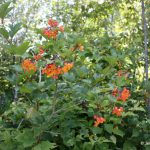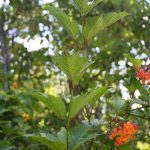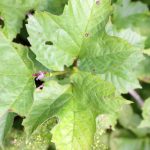American cranberrybush
Prepared by Jennifer L. D’Appollonio, Assistant Scientist, University of Maine, Orono, ME 04469. Updated February 2018.
Scientific name: Viburnum opulus L. var americanum Aiton.
Common name(s): American cranberrybush, American cranberrybush viburnum, highbush-cranberry, cranberry viburnum
Link(s): USDA PLANTS Profile, NPIN Profile, Go Botany
Images: (to see enlargements [PC]: click on image, then right click and choose “view image”)
- fruiting, mid-August
- leaf arrangement
- fruit detail
Description:
-erect native shrub
-can reach 6-10 feet in height
-close branching
-leaves are
- opposite
- 3-lobed maple-like leaves
- 2 to 5 inches long
- In the fall the leaves become scarlet.
-white flowers bloom late May and early June and measure 3 to 4 inches across
-The fruit ripens in September and October
- resembles the true cranberry in size and color
- is more translucent when ripe
– may be confused with V. acerifolium; see left sidebar on Go Botany webpage
– two subspecies in New England, the native ssp. trilobum and non-native ssp. opulus; see Flora Novae Angliae information on Go Botany webpage
Habitat:
-well drained to poorly drained soils
Agriculture:
-can be used as a windbreaker
-source of wildlife food
-Twigs are eaten by deer, moose and beaver
-Fruits are food for ruffed grouse, pheasants and songbirds.
Natural History:
-the fruit has been used o make preserves
Source(s):
USDA. “AMERICAN CRANBERRYBUSHViburnum Opulus L. Var. Americanum Ait.” Plant Fact Sheet , USDA NRCS Plant Materials Program, Feb. 2002, plants.usda.gov/factsheet/pdf/fs_viopa2.pdf.
Haines, A., Farnsworth, E., Morrison, G., & New England Wild Flower Society. (2011). New England Wildflower Society’s Flora Novae Angliae: A manual for the identification of native and naturalized higher vascular plants of New England. Framingham, MA: New England Wild Flower Society. p. 310.




